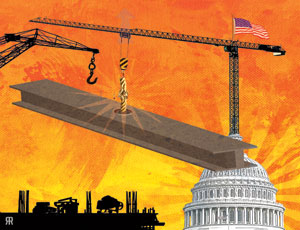In the American Recovery and Reinvestment Act’s first year on the books, its billions of construction dollars have been a lifeline for an industry battered by a long economic slump. Firms that snagged ARRA-funded contracts have been able to keep workers or add to workforces. Even so, construction has a jobless rate of nearly 25%. As companies chase ARRA projects, they’re looking for more help from Congress. But neither a jobs bill nor transportation authorization is a sure thing.

Since the stimulus was enacted on Feb. 17, 2009, its estimated $130 billion in construction spending has given the industry a lift. ARRA public-works project starts totaled $19.2 billion in 2009, keeping overall sector volume even with 2008, says Robert Murray, McGraw-Hill Construction vice president for economic affairs. Without ARRA projects, he says, public works would have dropped 16%.
The Associated Builders and Contractors’ Construction Backlog Indicator shows infrastructure is the sector with the healthiest amount of work. “The credit must go to the stimulus package,” says Anirban Basu, ABC’s chief economist.
Republican critics question the impact of the stimulus program on jobs. But a Jan. 13 White House report estimated that ARRA added or saved 262,000 construction jobs as of December. House Transportation and Infrastructure Committee Chairman James Oberstar (D-Minn.) says ARRA highway and transit projects added or preserved about 250,000 “direct, on-project jobs” as of Nov. 30.
Associated General Contractors’ CEO Stephen E. Sandherr says AGC members have reported a significant number of jobs saved because of the program. “Did it create all the jobs everyone expected?” No. Did it save jobs? Absolutely,” he says.
ARRA has done nothing to help private-sector construction, which remains in a deep slump. Further, state and local agencies are cutting programs. As a result, construction’s unemployment rate is rising, hitting 24.7% last month, its highest level since 2000. Without the stimulus, that number would have been worse.
Some are looking to Capitol Hill for another boost. In December, the House passed a $154-billion “Jobs for Main Street” package, including $47 billion for infrastructure. Senate Democrats are planning several small jobs measures, beginning in early February. Industry also wants a new surface-transportation bill, such as Oberstar’s $500-billion, six-year proposal. “We need the Jobs for Main Street continuation of stimulus,” Oberstar says, “but we need the certainty, the stability of a long-term transportation bill.”
But if Congress does clear a jobs bill, it will be much smaller than ARRA. Moreover, a multiyear transportation bill isn’t likely this year because the votes aren’t there for a gas-tax hike. As construction firms push for action in Congress, they will battle for remaining stimulus work. It’s about the only game in town.



Post a comment to this article
Report Abusive Comment